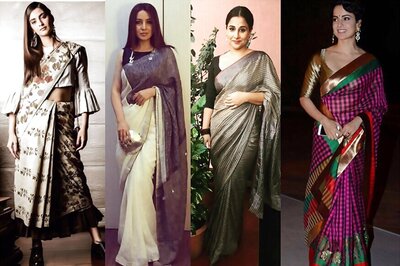
views
I too have always thought of chicken as a lacklustre, drab and characterless piece of flesh that needs the bulwark of Indian masalas to stimulate and provoke some flavours out of it. To date, I cannot stand a Chicken Biryani, a Chicken Dhansak or a Chicken Vindaloo, it makes my blood boil. I will not let anyone sully a mutton recipe, and surrender it to fowl, and thankfully I have never had to because we made such wonderful mutton dishes at home. And that’s where my love for goat meat or mutton grew.
India makes some of the world’s greatest mutton dishes, and when I say India, I mean right from the Yakhni and Rogan Josh in Kashmir to Mutton Pepper Curry Nanjil Nadu-style in Kanyakumari.
Rara or Dhansak?
So here are some of my favourite mutton dishes from India. Let me start with the Mutton Rara. Probably the most complex and extravagant of all Indian mutton preparations, this slow-cooked dish is a double dose of mutton in ghee. Legend has it Mutton Rara originated in the Himachal area, where it was cooked at dhabas along the highway. This may be true; even today most recipes for Rara are titled Himachali Rara Gosht. A classic Rara combines pieces of mutton that are cooked in gravy of minced mutton kheema.
While the recipe may vary from cook to cook, it is mutton cooked lovingly for hours over a slow fire, the meat and mince slowly mellowing in the fragrance and flavours of tomato, onion, whole black peppercorn, bay leaves, cinnamon, clove, star anise, black and green cardamom, cumin seeds and Kashmiri red chillies — the rich kheema gravy turning from deep red to brown in pure ghee. When garnished with slit green chillies, a squeeze of lemon and a hot naan are all you need. You break a morsel of mutton, scoop up some kheema and you’re in heaven.
From the west of India comes the Mutton Dhansak. Contrary to popular belief, Parsis do not eat Dhansak on a day of celebration; instead, it is traditionally cooked at home on the fourth day of mourning. Although Dhansak has now become a Sunday lunch staple in most Parsi homes. A version that explains the derivation of the name says that Dhansak comes from the Gujarati words ‘dhan’, meaning wealth, and ‘sak’ meaning vegetables. Pronounced slightly differently, ‘dhaan’ could also mean rice.
A Mutton Dhansak is a complex dish. At its most basic, it is meat cooked in daal. This daal consist of four pulses (tuvar, moong, masoor, urad) and a bunch of vegetables, (potato, brinjal, bottle gourd, red pumpkin) and fenugreek, all mashed together and surrendered to a heady mixture of onion, ginger-garlic and spices. This results in a robust, dark, thick, sweet, sour and spicy daal with chunks of mutton. This has to be eaten with steaming brown caramelised rice garnished with fried onions along with small fried minced meat balls and freshly chopped kachumber. Beware, this meal mandates a two hour nap after consumption.
Kosha Mangsho or Gongura Mamsam?
Gongura is such an indelible part of Andhra cooking that it is called Andhra Matha or mother. Gongura (sorrel leaf) is like spinach. It’s rich in iron, antioxidants and vitamins, and is peculiarly sour with a taste that is a bit difficult to explain, but finds many uses in Andhra food. Like Gongura Pachadi, a chutney, Gongura Pappu, a daal, Gongura Pulao and, of course, Gongura Mamsam (mutton). I first tasted Gongura Mamsam on a trip to Vizag. On a busy street I walked into a take-away place. Before me in steel containers was an array of Andhra dishes that I could choose and parcel. When I asked for mutton, they pointed at Gongura Mamsam. A thick oily greenish brown curry, coarsely leafy with succulent pieces of meat. I parcelled the mamsam along with some steamed rice and headed to a nearby park. There on a hill, under the sun with a view of the sea I mixed the mamsam with the rice and like a true-blooded south Indian proceeded to demolish the meal with my bare hands. The mutton was spicy as most Andhra food can be, and sour. As I said, I cannot explain the taste of Gongura, but it’s one you must not miss.
ALSO READ | What The Fork: We Are Not Italians, Let’s Not Use Tomato In Every Recipe, Writes Kunal Vijayakar
Synonymous with festivals and celebrations in Bengal is Kosha Mangsho. Years ago, I attended a large wedding in an old mansion in the Jorasanko Thakur Bari neighbourhood of North Kolkata. I was shooting a documentary and was there early. It was noisy. Family members yelling instructions in Bengali to each other, everyone talking at the top of their voices, but the noisiest noise came from the huge kitchen.
Nearly 1000 square feet-space strewn with wood fires, food here was being cooked by the gallons. Doi Rui (thick and spicy curry made with fish), Ilish Paturi (Hilsa and mustard, steamed in banana leaf); a cauldron full of oil was frying Maacher Chop (potato stuffed with spicy fish filling), Kabiraji Cutlet (chicken cutlets) and Koraishutir Kochuri (puris with green peas stuffing); a huge wok was frying Begun Bhaja (brinjal fritters); and steaming vessels of Alur Dom (spicy crisp potatoes in a creamy yogurt gravy) and Chingri Malai Curry (prawns fried in a rich coconut curry) sang on the fire. But in one huge pot were many kilograms of mutton, stirred with vigour. Dark rich and thick Kosha Mangsho. While Mangsho stands for mutton, Kosha literally means ‘bhuna’ or slow-cooked and continuously sautéing in ghee with onions and spices without adding water, so that the meat retains its moisture, and cooks and dries in its own juices. Along with Luchi (white pooris made with maida), nothing beats a well-made Kosha Mangsho.
The Mutton Pickle
And finally from Maharashtra, specifically Kolhapur. Sukka Mutton Loncha (pickle). Lavangi chillies, jaggery, Kolhapuri masala and kanda-lasun chutney (onion garlic chutney) form the foundation of Kolhapuri cuisine. The punch of the Kolhapuri cuisine comes from mutton and mutton is eaten in Kolhapur in many forms, whether it is rough-pounded kheema with bones, or the famous Sukka Mutton Loncha or pickle. Mutton is fried in oil, then cooked with dry coconut, ginger, garlic, poppy seeds, sesame seeds, red chilli powder, turmeric and kanda-lasun masala, and served with Rassa.
Now Kolhapur is the land of Rassa. Most mutton is served with a Rassa, a thin coconut curry. There are at least 14 kinds of Rassa in Kolhapur. Tambda, Pandhra, Pivla, Hirva and Kaala (red, white, yellow, green and black) and more, but the Chikna Rassa or Charbichi Amti is my favourite. It’s a curry made of fat. Mutton fat and soup bones are cooked with fried onion, garlic, dry roasted coconut and spices to create a sticky, viscous curry. Sukka Mutton Loncha can be served with either the Chikna Rassa or with the more popular Tambda Rassa (an intensely stormy red gravy with a tarri floating on top), and Pandhra Rassa (a delicately spiced, white, buttery gravy of coconut and garam masala). For me, I can eat the Sukka Mutton Loncha with Rassa for meals, and nibble at it straight from the fridge all through the day. But then do you really need a time and a place to eat mutton? I don’t.
The views expressed in this article are those of the author and do not represent the stand of this publication.
Read all the Latest News, Breaking News and Coronavirus News here.


















Comments
0 comment